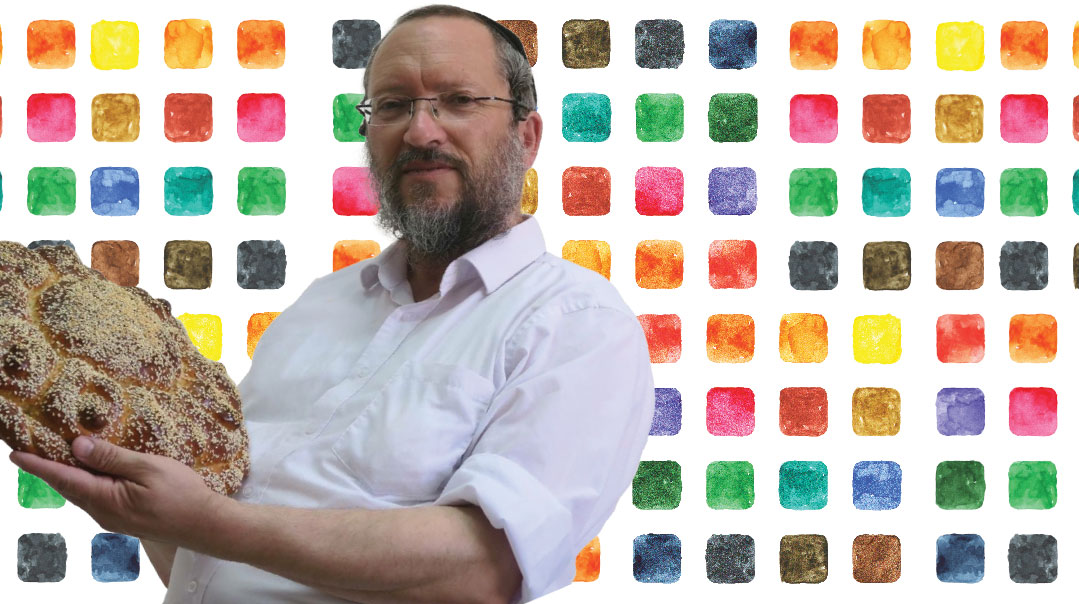With Flying Colors
| January 15, 2020Artist and cheder Rebbi Mota Brim creates a classroom of color

(Photos: Flash90, Family archives)
With his chassidish levush and graying beard, veteran preschool teacher Reb Mota Brim might not fit the profile of your typical artist. But this Boyaner chassid, a resident of the Jerusalem suburb of Beitar Illit, says he can’t walk down the street without creating paintings in his mind’s eye. He’s approaching 60, but has been attached to color, brushes, and sketch pads for as long as he can remember. “I wasn’t born with a brush in my hand, but in my stomach,” he says. “I always loved drawing, but I couldn’t even explain it to myself.”
When Mota was three years old, he contracted measles and had to spend hours alone in his room. To alleviate the boredom, his mother supplied him with colorful Plasticine to play with — and Mota spent hours molding the pliant material into shapes. A doctor came to check on him in the evening, and noticing the child’s creations, told his parents, “It’s a pity, you know — this boy is a natural artist, but you probably won’t let him develop his talents.”
The doctor was right about the first part, but thankfully not about the second.
“As a child I was obsessed with drawing,” says Brim, “and what I loved most was drawing near flowing water. Well, we didn’t exactly have a stream running through our small Jerusalem apartment, so I would go into the kitchen, turn on the faucet, lie down on the floor, and draw. Somehow that would give me the greatest inspiration, and I’m grateful that my parents didn’t object to this strange habit. I guess they figured my soul needed it.”
As a child he learned in the Jerusalem Talmud Torah where his father was a melamed. “When I was a child,” he admits, “many Yerushalmi melamdim didn’t seem to be aware that children could have other needs aside from learning, and the expectation was that you would learn well and not occupy your mind with anything else. The melamdim repeated the material again and again, and for a lot of children, it became pretty monotonous. They never considered the possibility that learning and davening could be made into an experience.
“Some children couldn’t concentrate and meet the high expectations, and teachers reacted with a heavy hand. And then the kid would go home and tell his parents, and they wouldn’t understand. ‘So why did you behave that way?’ they would say, taking for granted that if the melamed hit or punished their child, it was for a good reason.”
Brim says he was fortunate. He wasn’t a particularly distinguished student, but he wasn’t a troublemaker either, and on the whole was considered a good boy. In drawing, however, he was a star.
“The melamdim never even noticed it, but my friends did — they would crowd around my desk during recess and ask me to sketch them. So even though I was a pretty borderline student, I felt appreciated and valued.
Years later, Brim walked through those doors again, this time as a melamed himself. His first position was at the Mattersdorf Talmud Torah in Jerusalem. “It was a neighborhood Talmud Torah, and the students came from many different sectors, though the davening and learning was done in the litvishe pronunciation,” Brim recalls. “On my own initiative though, I added Yiddish, and until today, I meet avreichim, former students of mine, who tell me that thanks to me they speak Yiddish.”
When Brim found himself in the melamed’s chair, he made another discovery: “Every day I would sit with the boys some five or six hours, teaching them primarily Chumash and reading, plus a smattering of other subjects. And I picked up very quickly that after an hour and a half at most, a good number of the students just couldn’t absorb any more material. They couldn’t sit and concentrate — and I didn’t know what I was supposed to do about it.”
So what was a mainstream melamed in the mainstream system to do? “Well, because I didn’t really have much didactic knowledge, I decided to turn to some of the local kindergarten teachers. I asked them how they kept children engaged all day, and they explained how they drew and painted and did all kinds of creative projects with them. That made sense to me, and from then on I started teaching my students in a way that, I’ll concede, was definitely a bit out of the box. Every day we would sing for at least half an hour, and then we’d go out on a little excursion, returning to the classroom with sand, pebbles, and leaves. We created some beautiful things together.
“And do you know what was most surprising? That even when I eventually moved ‘down’ to teaching three and four-year-olds, they became extremely possessive of their own creations. Parents would sometimes ask me why their child drew so nicely at school but wouldn’t do it at home. I explained to them that the way to encourage talent is just to step aside, and let the kid express himself as he sees fit. If you start lecturing him about what was right or wrong in his drawing, it will paralyze him.”
When the cheder administration realized what was happening with the class, they were none too pleased. “One day the menahel himself walked in while we were making shapes with clay,” Brim remembers. “He was stunned and furious. The kids were filthy, and the room was splattered with clay. He started yelling at me, ‘This is how you teach!? How do you intend to complete the material?’
“I was a little offended, but I told him that as far as I was concerned, he could come at the end of the week and test the boys himself. If they didn’t know the material, I would take full responsibility. In the end, not only did the students know the material, but the following year, when the class was divided, all the parents wanted their children to be in my class.”
What Did They Look Like?
Once Brim was given a free hand, he indulged his artistic imagination, bringing his little charges into his own creative, multi-dimensional world. When they learned about the Meraglim, all the children dressed up as Biblical desert travelers, bearing grapes, figs, and pomegranates made out of large balloons; when they learned about the Parah Adumah, Brim created a cow out of red cardboard, which they then burned and sprayed with water. When they learned about maaser beheimah — tithing animals — he built an “animal pen” out of the tables in the classroom and as the “sheep,” the children crawled through one by one, and every tenth one was marked.
“I have to confess that over the years I had some tough classes too,” Brim admits, “but I decided that instead of allowing them to surprise me with their pranks, I would surprise them with my creative ideas, which would usually deflate their plans for making trouble.”
The main problem today, though, is the backlash to the strict, disciplinarian melamdim of yore who admittedly might have terrorized children who failed to meet expectations. “Today a melamed often finds himself in a trap, because if he raises his voice a bit, he might get enraged calls from parents about what damage he’s done to their children’s poor delicate souls. If he punishes, he could get a summons from the administration about how he’s abused his position. Today’s melamdim have so many creative tools at their disposal, but if children come to the classroom knowing that the teacher can’t punish them, then there’s no deterrence.
And instead of parents broadcasting a message that they and the melamed are unequivocally on the same team, Brim himself sometimes hears criticism from parents via the students themselves. He remembers how he heard from a student how that boy’s parents said it was forbidden to use the papers he gave out for parshas hashavua, because they contained illustrated Biblical figures.
“These parents claimed that it wasn’t acceptable that I had decided how Avraham Avinu should look, or what Moshe Rabbeinu or Yosef looked like,” Brim says. “I have to confess I was a bit miffed that they didn’t discuss it with me directly, but aside from that, it was important to me to know what daas Torah had to say about it. So I arranged a meeting with Rav Elyashiv and showed him my little dossier of drawings. He looked at the illustrations one by one. In the end he told me, ‘It’s permissible to draw figures from Tanach, but it needs to be done with reverence.’ He explained how these drawings would be imbedded in the students’ memories forever, that those pictures would be their primal associations.
“By the way,” he adds, “about two years ago I was contacted by a publisher who wanted to produce a book of illustrations for the parshah. He told me that he intended to consult Rav Chaim Kanievsky and asked if he could share what Rav Elyashiv, Rav Chaim’s father-in-law, had told me. So we went together to Rav Chaim, who basically reiterated Rav Elyashiv’s psak. But before we left, he peeked at a drawing I had done for parshas Noach and said, ‘It’s funny that you’ve remembered exactly what Noach looked like…’”
Reb Mota could be taking a stroll with his little charges through the park or walking alone down the street, yet there’s always something that inspires him to paint. “If I see a tree, a building, or even people walking, I don’t just see the objects, I notice the colors and moods that form each one — the way the sun hits or if the clouds are casting a depressing pall.”
Submitting to the Pros
Brim might have been considered a pretty good amateur artist growing up, yet once he married, he sought the advice of the Boyaner Rebbe about studying art in order to reach a more sophisticated and professional level.
The Rebbe understood the soul of this chassid, and not just from his paintings. Mota Brim is also a composer in the court of Boyan. “We’re the same age, and when the Rebbe got engaged — a few years before he became Rebbe — I composed a niggun for the occasion,” he says. It’s a bit of an understatement, as that niggun has since become a part of every simchah in Boyan.
The Rebbe encouraged Reb Mota, but with a stipulation: “Don’t study in a place that doesn’t honor and respect your lifestyle. And if you really want to excel, invest at least an hour in it every single day.”
Since then, Brim never lets a day pass by without painting.
But studying, at least in the beginning, was quite a shock to his system. “Up until then, everyone around me would compliment me on my drawings and considered me an expert. And suddenly, when I sat down with teachers who knew something about art, I understood that I was only a novice. I remember one day I presented a painting that took me hours, and when I finished I scribbled a quick sketch on another canvas. When the teacher appraised the painting, which took me all day, he said ‘very nice.’ But then he noticed the little sketch I had scribbled and his eyes light up. ‘Now here, you’ve accomplished something, here there’s a statement,’ he told me.”
It wasn’t easy to submit to the judgment of others, but Brim realized early on that it was the only way to learn. “If I painted what I thought was a leaf and they told me they didn’t see a leaf in the painting, I didn’t argue, I erased it. If I painted in red and they told me that marred the symmetry of the colors, I surrendered. I realized that was the only way to get professional. The more you submit to those with more professional judgment, the better you’ll get. True, you can be born with a ton of talent, but painting is a discipline with rules and principles, and if you don’t acquire them from professionals, chances are you’ll always remain an amateur.”
Brim qualifies, however, that it’s not just a matter of rules. Of course there is personal style and taste. “One person likes tomatoes and another likes cucumbers. You can’t force a person to like something that doesn’t appeal to him. But if you already like something, it’s possible to teach you how to bring it to its highest level, how to season it and arrange it on the platter, so that you enjoy the entire experience, not just the taste,” Brim explains. “And that’s the power of a true teacher, to allow the student to express himself while coaxing the talent upward.”
Brim says this not only as a former student but also as an art instructor who gives courses to men of all ages. “I teach young bochurim as well as retired men in their 70s,” he says. “There are also kollel avreichim who feel that painting is a way to express their neshamah, and they come in their spare time to hone their skills. In recent years people have become more open-minded about it across the board.”
It’s in the Dough
Brim’s paintings fetch between $5,000 and $10,000 — his customer base a diverse crowd of buyers from across the globe. One of his paintings is even displayed on a wall of the Supreme Court in Jerusalem. But there are no copies available cheap — Brim emphasizes that he sells only his original paintings and doesn’t do business with copies or numbered prints.
“The final price is determined largely by my attachment to the painting,” he says. “There are certain paintings that I simply can’t part from below a certain price. Of course, I also look at the demand and how long it took me to create the piece. But the truth is that even if you think these prices are making me rich, living off paintings isn’t particularly worthwhile. The ‘starving artist’ stereotype is often pretty accurate. I always tell my students, ‘Painting isn’t a parnassah.’ Sometimes the medium through which Hashem sends it is a painting, but you can never count on art as a steady source of income.”
Brim occasionally puts on exhibitions of his works in different cities around Israel. For each exhibition he chooses a specific theme, and one of his most recent — a nod to interpretive modern art (think the recent “banana and duct tape on a wall” which sold for $120,000) — is a theme he calls “challah stains” — actually, framed pieces of baking paper on which various shapes of challah were baked.
There’s actually a story behind the parchment paper, baked to perfection in Brim’s mind. “There was a time when, due to a family health situation, I was in the kitchen cooking the meals. And like everything else in my life, I began to see cookery as an art. After all, how can you compare a salad with yellow pepper to one without that burst of color? And then there are the aromas, and the tastes, and the seasoning — it all coalesces in my mind into shades that tell a story and form a painting.
“During that time, I started baking challos on Fridays,” he adds, and true to his artistic flair, began experimenting with intricate braids and shapes. “I would lay the braided dough on the baking paper, and then one week I paid attention to the interesting stains the baked challah left on the paper. I threw the paper away, of course, but the next week I noticed the stains again, and they were much more interesting this time, because I had done a double braid. It started to tickle my fancy. So I experimented, braiding and shaping the challos in a way that specific shapes would emerge on the paper, and sometimes I’d reuse a paper several times to achieve the desired effect. In the end I framed 30 papers and presented it as an exhibition in a gallery.
“If you look carefully at the challah stains you’ll find little illustrations — of the Lechem Hapanim [the show-bread in the Beis Hamikdash] or of the twelve shevatim. In one frame, you can even find a group of Jews dancing. Everything I’ve framed has meaning and significance.”
And there’s something else behind Brim’s attachment to challah. “I was recently invited to a chinuch conference in America, where participants were discussing how to bring more warmth and inspiration into mitzvah observance for children. I suggested that this may have to do with the fact that we occupy ourselves with mitzvos less and perform most of them by rote. So while children of previous generations saw their mothers kashering chickens, grinding fish, and baking challos, now the Shabbos food is bought at the supermarket and only has to be put on the blech. So if this exhibition inspires even one family to go back and bake their own challah, I feel I’ve accomplished something.”
Mota Brim’s work has been featured in galleries around the country, and he has a waiting list of men for his courses. So why is he still teaching three-year-olds in cheder kindergartens? “Little kids inspire me, they give me energy,” he says. “Look, I’m no longer young and don’t have the energy I used to, but working with these children, with their innocent creativity free of agendas and calculations, keeps me inspired. Isn’t that what every artist is looking for?”
(Originally featured in Mishpacha, Issue 794)
Oops! We could not locate your form.













